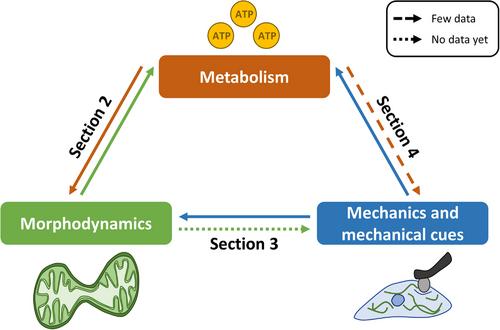Mitochondria: At the crossroads between mechanobiology and cell metabolism
Abstract
Metabolism and mechanics are two key facets of structural and functional processes in cells, such as growth, proliferation, homeostasis and regeneration. Their reciprocal regulation has been increasingly acknowledged in recent years: external physical and mechanical cues entail metabolic changes, which in return regulate cell mechanosensing and mechanotransduction. Since mitochondria are pivotal regulators of metabolism, we review here the reciprocal links between mitochondrial morphodynamics, mechanics and metabolism. Mitochondria are highly dynamic organelles which sense and integrate mechanical, physical and metabolic cues to adapt their morphology, the organization of their network and their metabolic functions. While some of the links between mitochondrial morphodynamics, mechanics and metabolism are already well established, others are still poorly documented and open new fields of research. First, cell metabolism is known to correlate with mitochondrial morphodynamics. For instance, mitochondrial fission, fusion and cristae remodeling allow the cell to fine-tune its energy production through the contribution of mitochondrial oxidative phosphorylation and cytosolic glycolysis. Second, mechanical cues and alterations in mitochondrial mechanical properties reshape and reorganize the mitochondrial network. Mitochondrial membrane tension emerges as a decisive physical property which regulates mitochondrial morphodynamics. However, the converse link hypothesizing a contribution of morphodynamics to mitochondria mechanics and/or mechanosensitivity has not yet been demonstrated. Third, we highlight that mitochondrial mechanics and metabolism are reciprocally regulated, although little is known about the mechanical adaptation of mitochondria in response to metabolic cues. Deciphering the links between mitochondrial morphodynamics, mechanics and metabolism still presents significant technical and conceptual challenges but is crucial both for a better understanding of mechanobiology and for potential novel therapeutic approaches in diseases such as cancer.


 求助内容:
求助内容: 应助结果提醒方式:
应助结果提醒方式:


